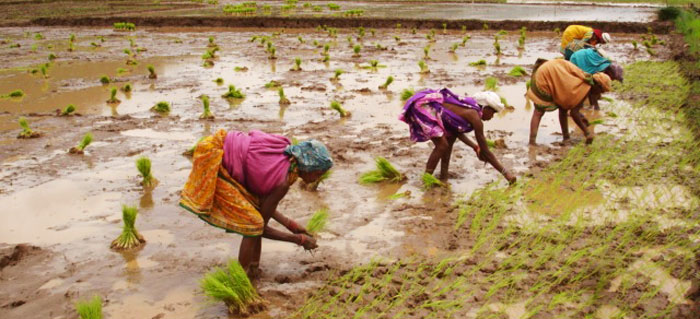Koraput Traditional Agriculture
Koraput Traditional Agriculture
Koraput Traditional Agriculture is one of the Globally Important Agricultural Heritage Systems (GIAHS) since 2012 recognised by the Food and Agriculture Organization of the United Nations.
The Globally Important Agricultural Heritage Systems (GIAHS) are agroecosystems inhabited by communities that live in an intricate relationship with their territory. These evolving sites are resilient systems characterized by remarkable agrobiodiversity, traditional knowledge, invaluable cultures and landscapes, sustainably managed by farmers, herders, fisherfolk, and forest people in ways that contribute to their livelihoods and food security.
Traditional farming systems in Koraput
 Traditional systems in the Koraput Region are strongly linked to the local traditional communities. From their knowledge and practices, a high biodiversity has been conserved through an in-situ conservation preserving endemic species. In spite of their invaluable ecological services, the local communities are part of the poorest of the country and the world. The food production is not always enough to satisfy all of their needs during the whole year.
Traditional systems in the Koraput Region are strongly linked to the local traditional communities. From their knowledge and practices, a high biodiversity has been conserved through an in-situ conservation preserving endemic species. In spite of their invaluable ecological services, the local communities are part of the poorest of the country and the world. The food production is not always enough to satisfy all of their needs during the whole year.
Being sustainable and integrated to its environment, the traditional farming systems of the local communities plays a role in conserving the rich floristic diversity consisting of about 2500 species of flowering plants. Strongly linked as a cultural trait, sacred grove is an effective method of preserving plant genetic resources. It is a biological heritage as well as social mechanism by which a forest patch is protected with a religious significance.
Due to the current threats toward forest and agrobiodiversity such as mining and deforestation, the recognition of this GIAHS would aim to enable rural families to derive economic benefit from their past and present contributions to conservation of genetic resources. This would be part of the social valorization and integration of the local communities.
Food and livelihood security
Local communities mainly grow their self-consumption food. However, it is not always enough to satisfy all of their needs during the whole year being sometimes critical. Paddy occupies around half of the cultivated lands. Other food crops such as maize, millet, green and black gram are cultivated. Besides, they manage food from different forest produce including roots, tamarind, tamarind seeds, leaves, jackfruits and seeds, mango stones.
The average income of a household comes from agriculture, poultry and employment as agricultural. To supplement their income and sustain their livelihood, local communities depend on forest produce for fuel wood, material for construction of their houses, agricultural implements, timber, and medicinal herbs. The tribal population depends on the low value non timber forest produces for their subsistence.
Biodiversity and ecosystem functions
This region is endowed with impressive biodiversity and is one of the primary centers of origin of rice. The cultivated diversity recorded in the region include: about 340 landraces of paddy, 8 species of minor millets, 9 species of pulses etc. Besides, new crops introduced are high yielding paddy and cash crops like sugarcane, cotton, and sunflower and improved vegetable varieties.
Being sustainable and integrated to its environment, the traditional farming systems of the local communities play a role in conserving the rich floristic diversity consisting of about 2500 species of flowering plants belonging to angiosperms.
However, due to threats such as deforestation and mining, the rate of loss of genetic diversity is very important dropping from 1800 rice landraces in the 60’s to 350 in the 90’s. The area, therefore, makes an excellent case for ecosystem approach to agricultural biodiversity conservation and management.
Knowledge systems and adapted technologies
Local communities’ knowledge is mainly about small scale fields integrated to the land forest management. The hill forest is used as agricultural field by the tribal by slash and burn method of agriculture. Using their indigenous knowledge they take the viability test for seeds before sowing, maintain the soil fertility and conserve the landraces of rice and other crops.
Strongly linked as a cultural trait, sacred grove is an effective method of preserving plant genetic resources. It is a biological heritage as well as social mechanism by which a forest patch is protected. The sacred grove has religious significance since it is believed that the vegetation is under the protection of their local deities. Even today we find forest patches left to local deities as a traditional custom.
Cultures, Value systems and social organizations
Tribal have rich traditional knowledge on the forest species. They identify and use plants for food, fodder, firewood, medicine, etc for their subsistence. More than 1200 medicinal plant species are available in this area. This healing system is part of the Indian traditional medicinal system.
Some exhaustive studies put into relief the religious aspects of the Sabara tribe of Koraput, covering even their magi co-religious beliefs about agriculture and food collection. Bondo tribe have complex magico-religious rites in seed conservation, fertility and production.
Remarkable landscapes, land and water resources management features
Integrated to its environment, traditional local communities’ cultivation has remained sustainable. Preserving the agrobiodiversity including cultivated and wild plants but also the traditional knowledge farmers had played a great role. That is why, forest preservation is a result of the human management.
Looking at the water resources management, agriculture is mostly rain fed. Small streams are used for irrigation. Recently some areas in the region have irrigation facilities originating from a major river has changed the traditional agricultural practices.
Source : FAO
Last Modified : 8/10/2024
This topic provides information about Overview of ...
Provides information about Globally Important Agr...
